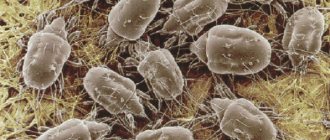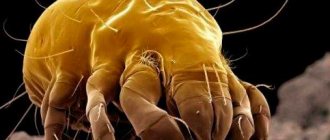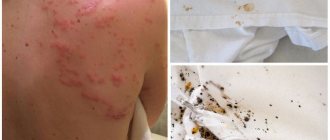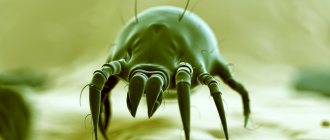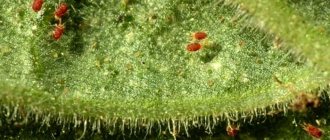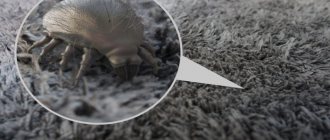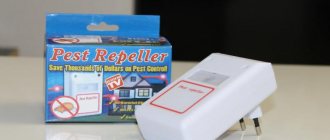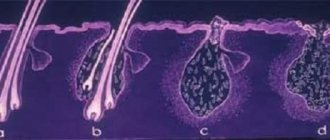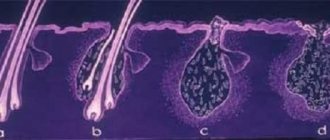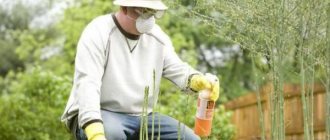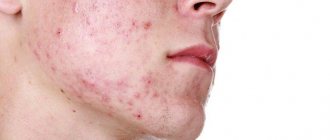The pest that lives in house dust cannot survive without people - it is a synanthropic organism. However, for a person such a “neighborhood” is fraught with health problems. In 1 g of house dust there lives a whole colony of microscopic arthropods - from 10 to 10,000 individuals. It is conventionally believed that 100 mites per 1 g of dust is a concentration that does not seriously affect human health. However, increasing this indicator is dangerous.
There are special preparations that allow you to determine the concentration of arthropods living in the house. For example, ACAREX TEST indicator strips.
Mite
The subcutaneous mite causes skin lesions in humans and animals - demodicosis. The mite settles in the hair follicles of the head, eyelashes and eyebrows, in the ducts and secretions of the sebaceous glands of the facial skin. A subcutaneous mite is a normal phenomenon, and for the time being it does not pose a danger, since it feeds on waste cells. But if the body’s defenses weaken, the mite begins to actively multiply, penetrates into the deeper layers of the skin and causes inflammation. According to the observations of researchers, women are more often affected by this disease.
FACT:
It is believed that more than 20% of people are carriers of demodicosis, but no clinical signs are detected.
Features of the parasite
The size of the parasite is negligible - 0.1-0.5 mm, it is impossible to see it with the naked eye. Microscopic arthropods live where dust usually accumulates: in pillows, upholstered furniture, mattresses, blankets and blankets, carpets and rugs, house shoes, between baseboards and the pages of books (sometimes a dust mite is called a paper mite).
Harm
Ticks themselves do not pose a danger to humans, but the products of their vital activity - feces, about 30 microns in diameter, contain special enzymes Der p1 and Der f1. These substances break down the human epidermis, providing food for pests. And, getting along with dust onto the skin and into the respiratory tract, they can cause a severe allergic reaction called mite sensitization.
Allergies can be of three types: contact, food and respiratory. Arthropods that live in dust can provoke each of them. As the parasite population increases, the following develop:
- bronchial asthma;
- atopic dermatitis;
- acarodermatitis;
- Quincke's edema;
- acariasis;
- conjunctivitis;
- rhinoconjunctivitis;
- respiratory allergies;
- allergic rhinitis.
Skin rashes and swellings look like dust mite bites, but in fact they are not. This is an allergic reaction triggered by pests.
An increase in the number of parasites to 500 individuals per 1 g of dust can provoke an asthma attack, and up to 1000-2000 - chronic rhinitis. According to statistics, approximately 2/3 of children diagnosed with bronchial asthma suffer from an allergy to house dust mites.
Life activity and varieties
The parasite, in scientific circles called the dermatophagoid mite, lives for about 80 days, laying about 60 eggs during this period. Comfortable conditions for the growth and reproduction of the pest are high humidity (more than 55-70%) and an air temperature of 22-26°C.
Arthropod parasites living in house dust are divided into three groups:
- pyroglyphides - or granary, feed on particles of human skin;
- predatory - eat representatives of the first group;
- random - they are carried into the dust from outside, and will not reproduce indoors.
Anton Van Leeuwenhoek is known as the inventor of the microscope. It was he who was the first to examine mites in dust in the second half of the 20th century.
Signs of presence
You can suspect the presence of too many parasites in a house only by indirect signs, since pests cannot be seen with the naked eye. The following symptoms observed in household members indicate that it is time to sound the alarm:
- coughing attacks;
- watery eyes;
- chronic runny nose;
- skin rashes.
If, while in a certain room, headaches, poor health, and fatigue are noted, there is also a possibility that the permissible limit will be exceeded.
If any manifestations are detected, you should immediately contact an allergist and undergo an examination. An allergy to dust mites can be fatal.
On the Internet, a dust mite is often called a saprophyte. But this is a mistake. A saprophyte is any microorganism that feeds on dead particles and converts these substances into inorganic compounds. Saprophytes feed on dead ticks and their secretions. These microorganisms are safe for humans, with the exception of some species that are classified as opportunistic.
Signs of illness
In its manifestations, damage to the subcutaneous mite is very similar to rosacea or acne. Peeling of the skin and its redness are noted, itching may occur, constant or worsening after using tonics or washing with cold water. Sometimes there is a combination of demodicosis caused by subcutaneous mites and the above-mentioned skin diseases. And this is not surprising, because the occurrence of demodicosis is influenced by negative changes in the skin. Thus, both acne vulgaris and rosacea weaken the skin’s natural defenses. When affected by skin mites, the following parts of the face are most often affected: eyelids, forehead, chin, nasolabial folds and brow ridges. Exacerbations of demodicosis occur in autumn and spring.
Scabies:
Scabies is a common parasitic skin disease. The fight against it is being carried out comprehensively. Treating items for scabies is one of the necessary measures that can protect against re-infection with mites.
Disinsection is aimed at stopping the spread of infection and preventing self-infection.
Algorithm for treating things and premises with scabies
Itching is practically indistinguishable to the naked eye. Males fertilize females only once, after which they can lay eggs for the rest of their lives.
It is especially difficult to exterminate such parasites. The only female that survives after all treatment measures will become the source of a second outbreak in the outbreak.
Ticks can live for several days outside the human body, so to properly carry out disinfestation you need to know the places where they accumulate. Parasites can end up on clothes, towels, dishes, and beds.
Scabies also get on upholstered furniture, carpets, and mattresses. Any object that is often used by a scabies patient can be a source of infection.
Methods for killing ticks on objects and indoors can be divided into:
Didn't understand the article or need help? Ask a question now and get an answer.
- chemical - acaricidal solutions;
- physical - at a temperature of 60 degrees, parasites die within one hour, and in the cold and when boiling instantly.
The first most popular is the chemical method. Modern professional preparations are used to kill ticks:
- Allegroff;
- Easy air;
- Milbiol.
Parasite eggs are more resistant to disinfectants, as they are covered with a durable shell that reliably protects the embryos from external influences. Fortunately, scabies never lays eggs outside human skin. Therefore, disinfection measures are aimed only at the destruction of adult individuals.
Disinfection algorithm:
- Preparation;
- primary processing;
- processing the patient's belongings;
- disinfection of the apartment;
- final processing.
During the course of treatment for scabies, you need to clean and ventilate the room daily. All clothes and bedding of the patient and all members of his family must be disinfected.
What do you need to buy?
Disinfectants for treating things and premises against scabies can be chlorine-based or non-chlorine-based. They can be purchased at the pharmacy chain. The most commonly used aerosol is A-PAR .
When washing floors, walls and windows, add soda to the water (a tablespoon per liter of water) or any household detergent with a disinfectant effect.
To process the premises, you will need gloves and garbage bags, which should be purchased in advance.
Primary manipulations
During the treatment of scabies, it is better to remove from the room objects that could easily become itchy. These are textile carpets and soft toys.
It is necessary to temporarily replace pillows and blankets stuffed with wool, down or feathers with synthetic analogues. Furniture should ideally be packed in thick covers that can be easily washed at high temperatures.
Actions after completion of treatment
A week after the end of treatment, a final general cleaning is carried out. Floors and other hard surfaces are wiped with a soda solution and then with clean water.
All fabric items are washed again with washing powder, dried and ironed with a hot iron.
Basic information about scabies in the video:
A set of measures for final disinfection:
- wash all surfaces in the apartment with a disinfecting liquid (boiling water with a little laundry soap and soda ash added will do);
- cleaning equipment is soaked in a household washing and disinfecting solution, then rinsed and dried;
- plumbing fixtures are cleaned with detergent;
- The patient's things that can withstand boiling are immersed in cold water and brought to a boil. Boiling can last up to 15 minutes.
Careful implementation of all measures for disinfestation of the premises and personal belongings helps to avoid a re-outbreak of scabies.
It is possible to defeat parasites!
Antiparasitic Complex® – Reliable and safe removal of parasites in 21 days!
- The composition includes only natural ingredients;
- Does not cause side effects;
- Absolutely safe;
- Protects the liver, heart, lungs, stomach, skin from parasites;
- Removes waste products of parasites from the body.
- Effectively destroys most types of helminths in 21 days.
There is currently a promotion for free packaging. Read expert opinion.
Source: https://otparazitoff.ru/chesotka/obrabotka-veschey.html
Risk factors
As mentioned above, what is unpleasant is not the presence of a subcutaneous mite as such - in itself it cannot harm a healthy person - but demodicosis, which is caused by a mite. If the body is weakened and there are additional risk factors, the tick can settle in the skin for a long time and cause considerable mental and physical damage to its “breadwinner”. Risk factors include:
- dysfunction of the sebaceous glands, changes in the composition of sebum, vascular changes;
- some skin diseases (rosacea, acne, seborrhea);
- long-term use of hormonal corticosteroid ointments;
- adolescence;
- pregnancy;
- stress.
Unfortunately, non-specialists react with unacceptable ease to the appearance of acne on the face and body. The appearance of such problems is attributed to age and ordinary acne, which sooner or later should disappear on their own. We have to disappoint you: demodicosis caused by subcutaneous mites will not go away on its own. The disease can travel from one area of the skin to another, existing for years and ruining the life of its “donor”.
IMPORTANT:
squeezing out acne when infected with a subcutaneous mite only leads to an exacerbation of the infection, since during this process the mites are pressed into healthy areas of the skin and infect them.
Make an appointment
Ticks in sofas: how to get rid of them quickly and forever
Professionals recommend throwing away or removing all unnecessary “dust collectors”: mattresses,
feather beds, carpets. A smart move would be to replace massive fabric curtains with modern washable blinds. Additional measures will help destroy dust mite colonies:
– In winter, you need to take the bed or potentially infected things out into the cold. Within 2 hours the beetles will die. True, such actions are quite problematic to carry out; turning to specialists to exterminate ticks is much preferable.
– You can try to use an ultraviolet lamp and thoroughly treat areas that are difficult to reach when washing, but the result of such actions is usually invisible.
– It is necessary to ventilate rooms in a timely manner in any weather.
– When cleaning, wash surfaces with a 20% solution of regular soda.
Calling a team of disinfectants will save residents from the hassle. We use modern equipment and drugs directed against ticks, safe for all warm-blooded animals, destructive for microscopic arachnids. Specialists will be able to efficiently process porous surfaces and remove accumulations of dust mites quickly and efficiently.
Treatment
Treatment of demodicosis caused by subcutaneous mites is a long and difficult process. Its complexity is that often this disease develops against the background of a decrease in the body’s defenses and has accompanying skin problems. Therapy tactics include suppressing the parasite, treating underlying diseases and increasing immunity.
The most commonly used local therapy is lotions and special ointments. In more severe cases, the doctor prescribes a course of antibiotics in combination with external therapy. Sometimes plasmapheresis procedures are recommended. In special cases, even surgical intervention is possible.
An important point in the course of treatment is diet. It is necessary to exclude hot, spicy and salty foods, foods rich in carbohydrates and fats from the diet. Those who are being treated for subcutaneous mite infestation are recommended to consume large amounts of fruits, vegetables, microelements, fiber, and dairy products. During treatment, you should not use face masks, especially those containing honey. You need to limit your exposure to the sun. You should also wait until better times to visit the bathhouse and sauna.
Professional fighting methods
If you are going to call a disinfection specialist so that he can treat your apartment against bed mites in one session, then this procedure will only take a few hours. However, you won’t be able to stay in the treated room for about a few days, and then you will need to wash everything in hot water and wash it, so ventilate it. Specialists can be called from the FBUZ - Center for Hygiene and Epidemiology.
The cost of treating a 1-room apartment with domestic professional preparations using a hot or cold fog generator will be about 800 rubles, with a guarantee for 12 months - 1200 rubles, with a guarantee for 12 months and using imported odorless insecticides - 2000 rubles . These methods allow the cloud of the drug to remain in the air for several hours, penetrating into all microscopic cracks, cracks, etc. filling everything around, so the fog covers a large amount of area, destroying parasites.
Possible consequences of bites
What danger could such creatures pose? It should be noted right away that the adult individuals themselves, or their larvae, do not bite humans. Those reddish spots, stains, swelling, rashes and other manifestations that appear on the skin are the result of allergies. This human health problem arises from the feces of these parasites, and not from them themselves. In general, ticks can cause the following reactions and diseases with their excrement:
- rhinitis;
- asthma;
- bronchitis;
- acariasis;
- Quincke's edema;
- allergosis affecting the respiratory system;
- dermatitis (atopic);
- conjunctivitis.
Feces contain so-called enzymes, those proteins that cause the death of the victim’s skin cells, which, in turn, provides sufficient nutrition for the parasites. But at the same time, they serve as provocateurs for the onset of dangerous diseases in humans.
